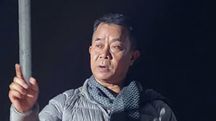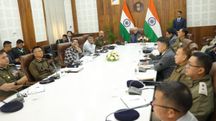Japanese war historian provides new perspectives on Imphal-Kohima battles, mentions INA’s major contribution
Japanese historian Tohmatsua Haruo teaches at Japan’s National Defense University, has finished editing a fresh compilation “Battles of Imphal and Kohima: Japanese Operations in Northeast India” told this writer that the Japanese-INA failure owed much to “strategic confusion” at the highest levels of Japanese wartime decision making.
 Japanese historian at a press conference discussing on the new volume of compilation on Imphal-Kohima battles soon to hit the market
Japanese historian at a press conference discussing on the new volume of compilation on Imphal-Kohima battles soon to hit the marketA Japanese war historian has provided new insights into the Imphal-Kohima battles that ensued in the World War 2. The edited new volume of the Imphal-Kohima battles has come up with fresh perspectives on the war vestiges that was designated as the bloodiest battle of World War 2.
Japanese historian Tohmatsua Haruo teaches at Japan’s National Defense University, has finished editing a fresh compilation “Battles of Imphal and Kohima: Japanese Operations in Northeast India” told this writer that the Japanese-INA failure owed much to “strategic confusion” at the highest levels of Japanese wartime decision making.
The edited compilation will be hitting the market soon.
The Imphal-Kohima battles, fought between 8 March and 18 July 1944, marked the turning point in one of the most gruelling campaigns of WWII (1939-45). The decisive Japanese defeat in north-east India served as a springboard for the subsequent re-conquest of Burma by the Fourteenth Army.
"Japanese leaders were more interested in crushing the Kuomintang resistance and seizing control of China than in pushing into India. That is why, after overrunning Burma (now Myanmar) with unusual force and a force much smaller than the British, they did not press on into Northeast India. The British were demoralised in 1942, India was in the grip of the Quit India movement, and the Japanese army appeared unstoppable," Haruo told this writer.
But, he claimed, the Japanese were more eager to cut off Allied supplies to Chiang Kai Shek from Northeast India via Burma, allowing the Kuomintang army to be decisively defeated and much of China seized.
"It was only after Subhas Chandra Bose arrived in East Asia and persuaded Premier Tojo that India could win its freedom because the INA could cause large-scale defections of Indian soldiers in the British army that Japan decided on the Imphal-Kohima offensive," Prof Haruo told this writer on the sidelines of a press conference announcing the publication.
He claimed that Japanese commanders in Burma decided to launch the Imphal-Kohima offensive in order to end the extensive British operations behind Japanese lines (dubbed the Chindit operations) that were impeding the Japanese push towards Yunnan via North Burma.
The arrival of Subhas Bose in East Asia had much to do with the Japanese decision to launch the Imphal-Kohima offensive, according to historian N.Lokendro Singh, VC of Manipur University.
"Japanese leaders were so impressed with Bose and his samurai image that they ignored adverse military logistics factors and decided to proceed," Prof Singh explained.
He claimed that the Imphal-Kohima battles were Northeast India's first encounter with globalisation, and that it had a significant social impact in the region.
"With the exception of those influenced by Christian missionaries and V Force, most communities in Manipur supported the INA-Japanese campaign," he said.
Also read: Russia fires 70 missiles on Ukraine; 4 dead, over 100 injured
Copyright©2025 Living Media India Limited. For reprint rights: Syndications Today









